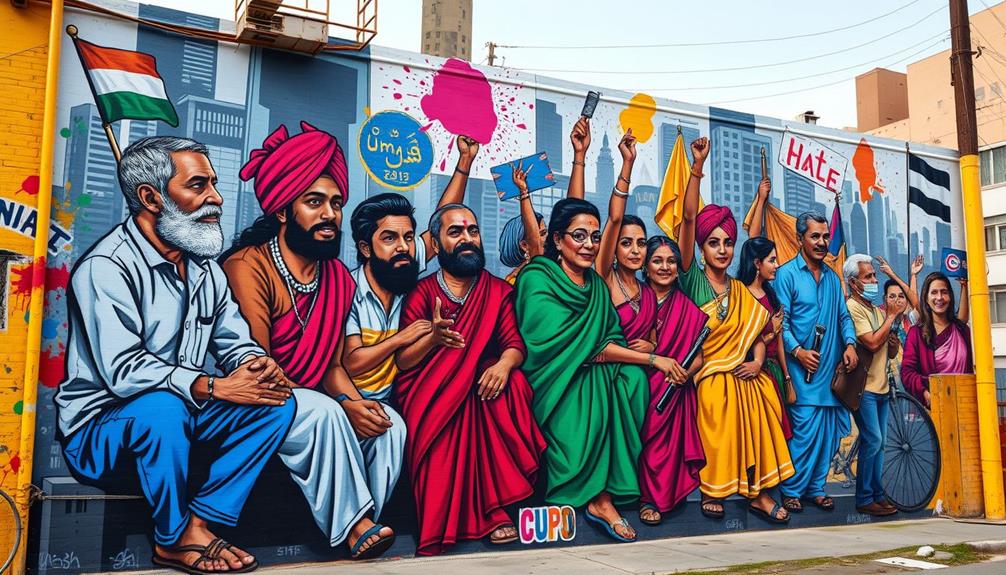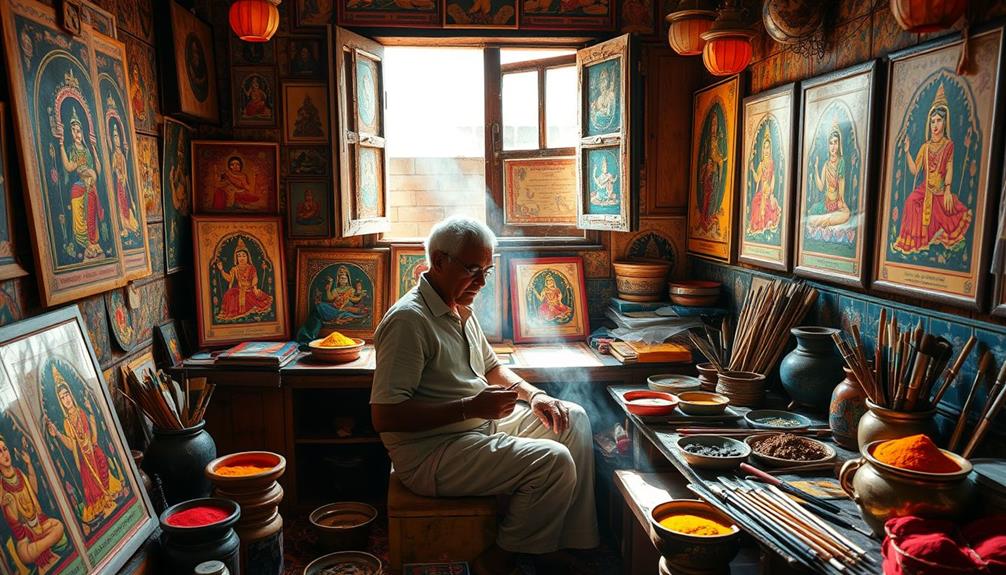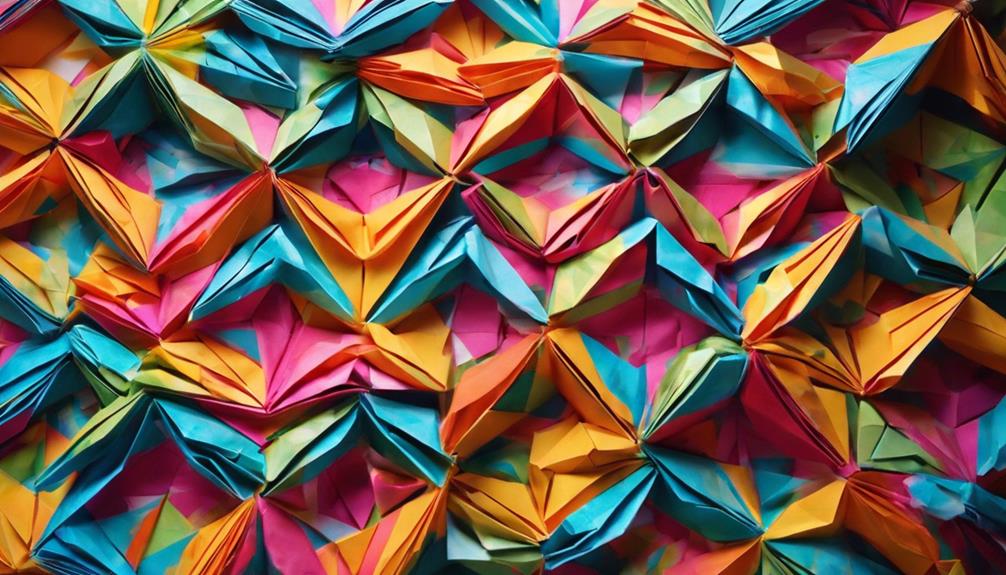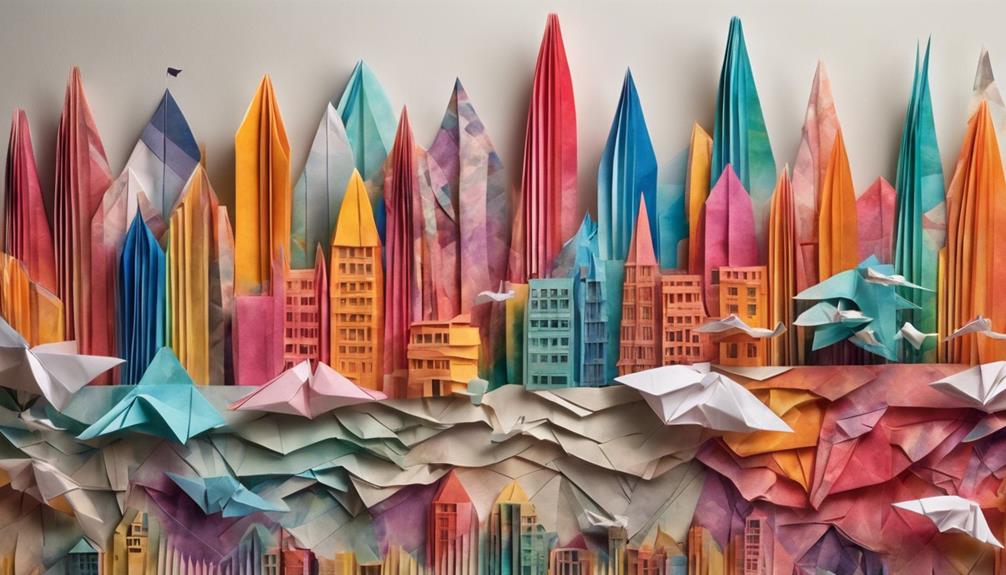Art in India plays a significant role in tackling social issues and sparking change. It encourages you to confront injustices, from gender violence to caste discrimination. Artists like Nalini Malani address pressing issues through powerful installations, while Daku's murals raise awareness about harassment. Community art projects foster dialogue and empower individuals to share their stories, uniting communities for action. Environmental artists also inspire collective responsibility toward ecological crises. By engaging with these creative expressions, you can appreciate how art transforms awareness into activism, seamlessly connecting society's struggles with powerful narratives. There's much more to uncover about this vibrant movement.
Key Takeaways
- Artistic activism in India has a rich history, using visual storytelling to confront colonialism and marginalized community struggles.
- Contemporary artists like Nalini Malani and Daku address gender violence and sexual harassment through impactful murals and installations.
- Environmental art connects communities to ecological issues, inspiring collective action and raising awareness about climate change and pollution.
- Community engagement in art projects empowers individuals to share their narratives, fostering dialogue on social justice and collective identity.
- Initiatives like Shanti Arts for Action promote youth empowerment and address pressing issues like human trafficking through creative expression.
Historical Context of Artistic Activism
Artistic activism in India has deep roots that stretch back to the early 20th century, when artists like Nandalal Bose and Abanindranath Tagore used their creativity to challenge colonial rule and highlight social injustices. In this historical context, you'll see how Indian art became a powerful medium for activism, addressing issues like inequality and caste discrimination.
Artists employed visual storytelling to bring attention to the struggles faced by marginalized communities, often facing political corruption and oppression. Similar to the cultural significance of storytelling in Aboriginal practices, these artists utilized narrative techniques to amplify their messages and connect with the public.
The late 20th century witnessed movements such as the Narmada Bachao Andolan, which effectively utilized theater as a form of protest against human rights violations related to dam construction. This marked a significant evolution in the role of art in social movements, emphasizing its effectiveness in advocating for change.
Post-independence, the landscape of Indian art further transformed, reflecting the country's complex socio-political realities. Contemporary artists, inspired by historical narratives, continue to engage in activism through their work, ensuring that the legacy of using art to confront social injustices remains vibrant.
Prominent Artists and Their Impact
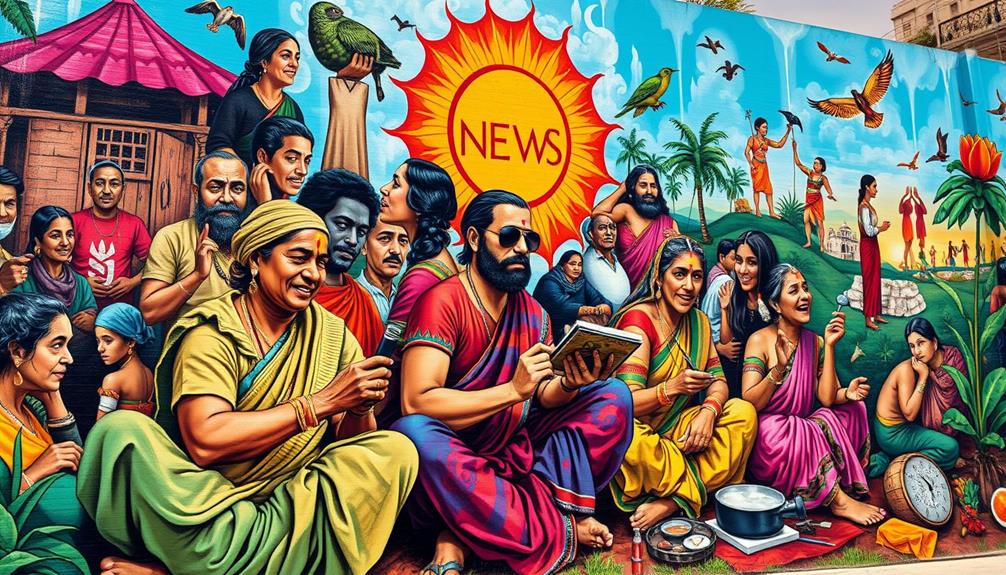
In the vibrant landscape of contemporary Indian art, several prominent artists are making significant strides in addressing social issues through their work. Nalini Malani's installation "In Search of Vanished Blood" confronts gender violence, utilizing video projections and sculptures to advocate for social justice and raise awareness about the plight of rape victims.
Similarly, Daku's "Leave Me Alone" mural series sparks discussions on sexual harassment in public spaces, emphasizing the urgency of addressing gender inequality. The emotional impact of such art can resonate deeply, fostering a sense of connection and empathy among viewers, which is essential in maneuvering tough conversations around these issues active listening enhances understanding.
Shilo Shiv Suleman's mural "Our Time Has Come" celebrates young climate activists, positioning art as a tool for empowerment and a catalyst for social change.
Meanwhile, Ravi Kumar Kashi's "Ambedkar in Nagaland" highlights resistance against caste discrimination, echoing the struggles of the Dalit community.
These artists, along with initiatives like Shanti Arts for Action, showcase the profound impact on society through collaborative mural painting and performances. Their works not only beautify urban landscapes but also serve as powerful feminist art, driving conversations about pressing social issues.
In doing so, they transform visual arts into a significant platform for advocacy and empowerment.
Art and Gender Issues
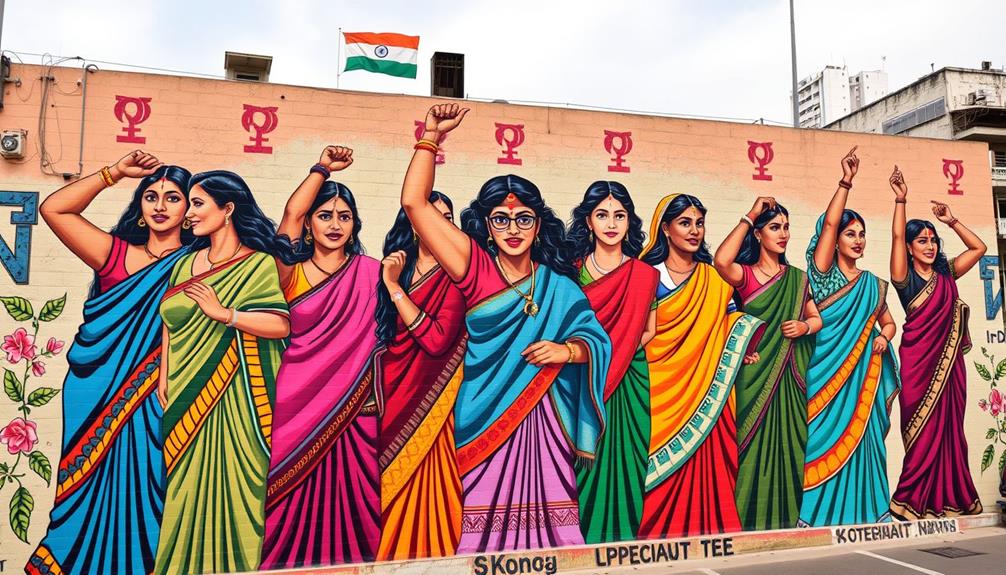
Through powerful visual expressions, artists in India are tackling gender issues head-on, creating a dialogue that resonates deeply within society. This artistic engagement is essential, as it not only highlights the struggles faced by women but also reflects the broader societal dynamics influenced by the characteristics of narcissism, such as manipulation and control.
From Nalini Malani's poignant installation "In Search of Vanished Blood," which confronts gender violence and advocates for justice, to Daku's "Leave Me Alone" mural series that highlights the reality of sexual harassment in public spaces, the art community is raising awareness and inspiring action.
In the wake of the Nirbhaya case, artists have amplified their voices through various mediums, creating impactful installations and performances that advocate for women's empowerment and rights. Initiatives like the Kala Ghoda Festival mural project showcase collaboration between local artists and students, emphasizing the ongoing struggles for gender equality in India.
Additionally, community art projects led by organizations like Mumbai Smiles engage youth in creative expressions, transforming them from victims to advocates for social change.
These efforts illustrate how art and gender issues intersect, serving as a powerful tool to challenge societal norms and promote women's empowerment. By fostering these conversations, artists help pave the way for a more equitable future, encouraging everyone to participate in this essential movement.
Environmental Art and Activism
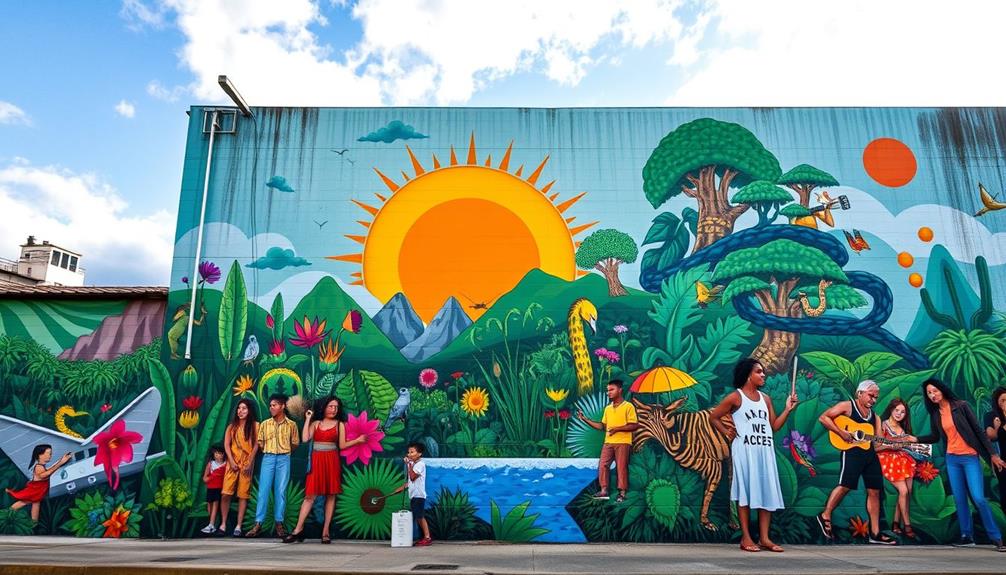
Environmental art in India serves as a powerful medium for activism, connecting communities with pressing ecological issues. Through various public art projects, artists highlight concerns like pollution and deforestation, engaging audiences in significant conversations about climate change. By fostering awareness and promoting sustainability, these artistic efforts contribute to a broader movement towards environmental stewardship, akin to strategies seen in energy-efficient upgrades.
- Visual storytelling: Murals and installations, like Shilo Shiv Suleman's "Our Time Has Come," celebrate young climate activists and spread hope.
- Community engagement: By integrating traditional art with contemporary themes, artists inspire collective action and foster a sense of belonging.
- Youth empowerment: Initiatives like "Shanti Arts for Action" encourage young people to express their views on environmental concerns through creative outlets.
Art installations and performances mobilize support for movements, such as the Narmada Bachao Andolan, which tackled human rights violations linked to dam construction.
This blend of creativity and activism not only raises awareness but also transforms spaces into platforms for social change. As you engage with these artistic expressions, you become part of a larger narrative calling for action against ecological degradation.
Embrace the power of environmental art and join the movement towards a sustainable future.
Addressing Caste Discrimination Through Art
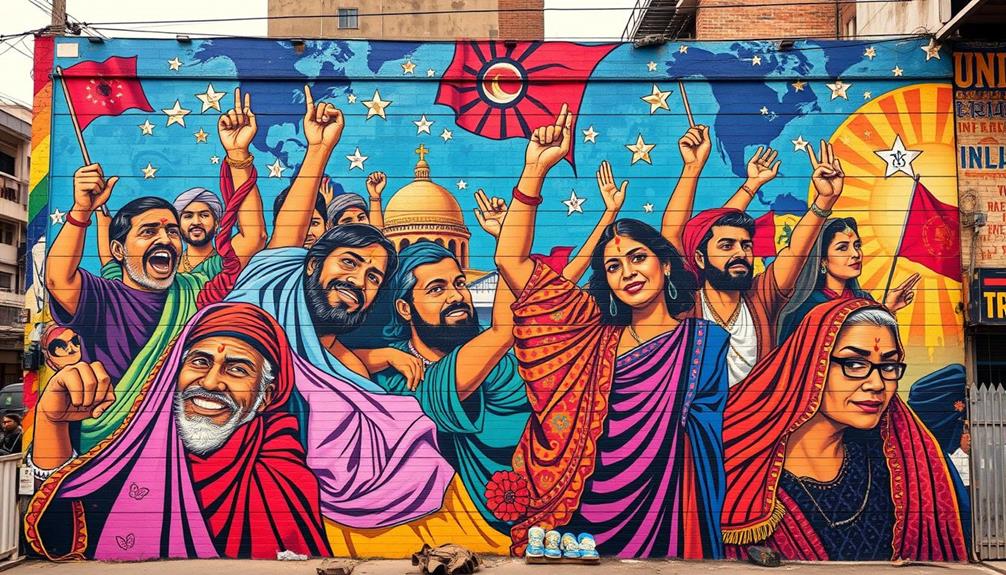
Art plays an essential role in addressing caste discrimination in India, serving as a powerful tool for advocacy and awareness. Dalit artists like Ravi Kumar Kashi and Durgabai Vyam use their work to confront social justice issues through visual storytelling. For instance, Kashi's mural "Ambedkar in Nagaland" symbolizes hope and resistance, highlighting ongoing caste-related injustices.
Artistic activism fosters dialogue about these systemic issues and engages communities in critical discussions. Community art projects provide a platform for marginalized voices, raising awareness and inspiring change.
Here's a table illustrating the impact of art on caste discrimination:
| Art Form | Purpose | Impact |
|---|---|---|
| Murals | Raise awareness about caste issues | Foster dialogue and reflection |
| Installations | Confront social justice challenges | Engage audiences in discussions |
| Community projects | Empower marginalized voices | Inspire systemic change |
Through these efforts, art not only challenges societal norms but also promotes equality and justice, ensuring that the struggles of the Dalit community are seen and heard. You can witness how powerful artistic activism can be in the fight against caste discrimination.
Community Engagement in Art Projects
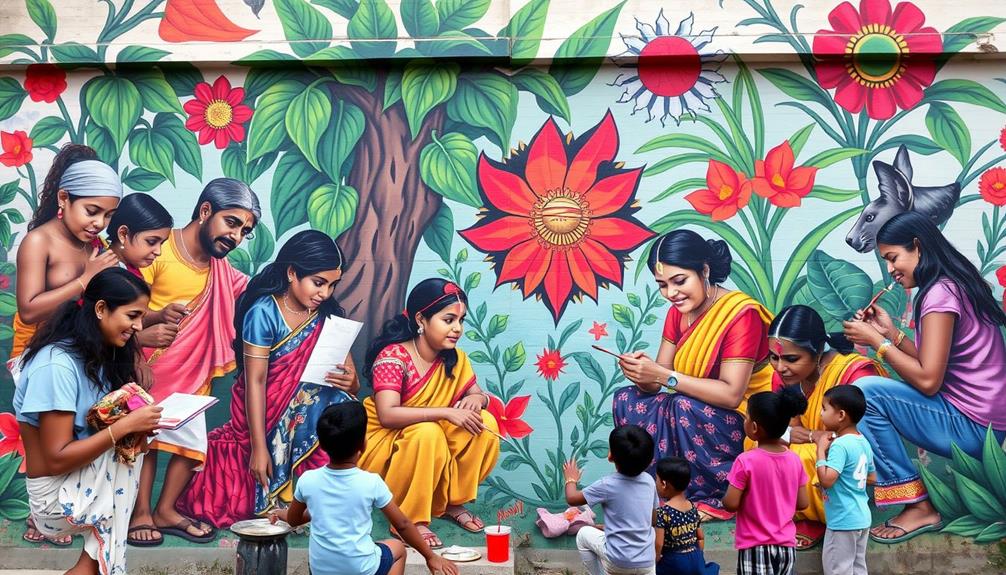
In recent years, community engagement in art projects has emerged as an essential means of empowering marginalized groups across India. By collaborating with local artists, participants can express their concerns through creative mediums that resonate deeply within their communities.
These initiatives not only foster dialogue but also bring critical social issues to the forefront, much like the way artists intertwine creativity with historical context to highlight cultural resonance.
Consider the impact of these projects:
- Youth Empowerment: Programs like Shanti Arts for Action encourage young people to take ownership of their narratives, addressing issues like human trafficking through public art.
- Gender Equality: Festivals such as Kala Ghoda engage communities in discussions about gender-based violence, allowing voices to be heard and change to take root.
- Transformative Experiences: Workshops by organizations like Mumbai Smiles enable participants to create skits and murals, turning victims into agents of change, highlighting issues like child labor.
Through these community engagement efforts, art becomes a powerful tool for addressing social issues, bridging gaps between marginalized groups and the broader society.
The Future of Art for Social Change
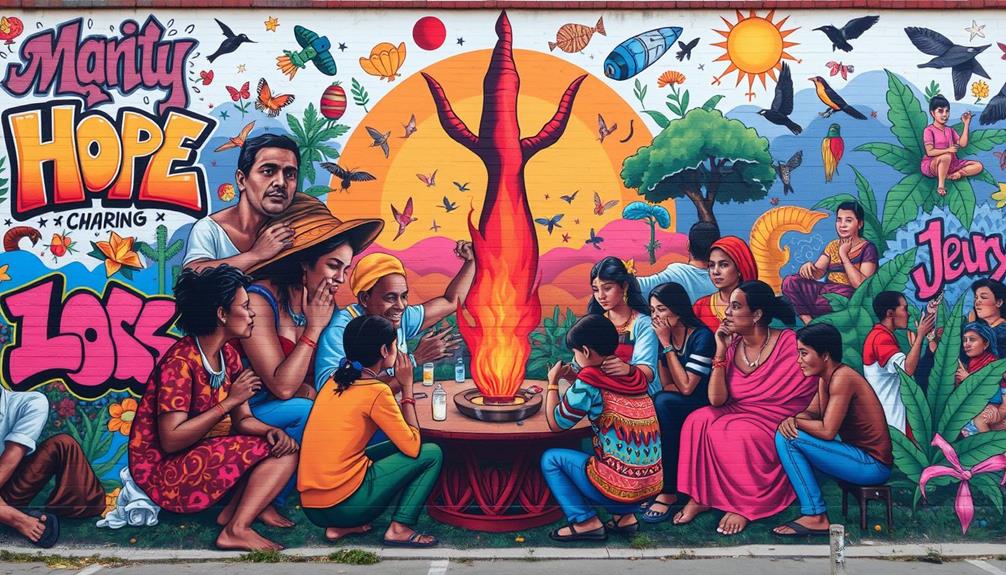
As community engagement in art projects continues to flourish, the future of art for social change looks increasingly promising. You'll witness a growing movement where artists harness their talents to tackle pressing social issues like gender inequality and human trafficking.
Initiatives such as Shanti Arts for Action exemplify how youth empowerment projects in cities like Mumbai and Delhi can inspire action through creative expression. This collaborative approach mirrors the methodical approach seen in successful software quality assurance practices, guaranteeing that every project is executed with care and precision.
Collaborative mural projects are becoming a powerful form of collective artistic expression, uniting local communities and artists to address social injustices. These murals not only beautify neighborhoods but also serve as rallying cries for change.
Environmental art is also gaining traction, with artists like Shilo Shiv Suleman crafting works that resonate with younger generations and promote climate action.
Moreover, integrating art education into schools and community programs guarantees that the next generation of socially conscious artists will continue this significant work. As they learn to use their creativity as a catalyst for societal change, you can expect to see innovative approaches to art for social change, ultimately transforming communities and inspiring others to join the fight against social injustices.
Frequently Asked Questions
What Is the Role of Art in Addressing Social Issues?
Art plays a vital role in addressing social issues by sparking conversations, raising awareness, and inspiring change. You can use creative expression to challenge injustices, empower communities, and transform societal narratives for a better future.
What Role Do the Arts Play in Indian Society?
In vibrant street murals and resonant performances, you'll see art as a heartbeat of Indian society, sparking conversations, igniting change, and weaving together diverse voices into a tapestry of culture, identity, and resilience.
What Role Do Art and Culture Have in Bringing Awareness to Social Issues?
Art and culture amplify social issues by sparking conversations and challenging norms. You engage with powerful visuals and performances, which inspire empathy, provoke thought, and mobilize communities towards understanding and addressing these pressing societal concerns.
What Is the Role of Art in Social Function?
Art shapes perspectives, challenges norms, and fosters connections. You'll find it influences social functions by encouraging dialogue, reflecting identities, and inspiring action. Through these avenues, it becomes an essential tool for community engagement and collective growth.
Conclusion
You might think art can't change the world, but it plays an essential role in addressing social issues in India. It sparks conversations, challenges norms, and mobilizes communities. From highlighting gender inequality to fighting caste discrimination, artists are at the forefront of social activism. By engaging with their work, you can be part of this transformative movement. So, don't underestimate the power of art; it's an important tool for creating a more just society.
